Q-talk 154 - Tri-Q Redesigned Mid-span Elevator Hinge
- Details
- Category: Q-Talk Articles
- Published: Wednesday, 29 August 2012 13:00
- Written by Jay Scheevel
- Hits: 6587
Tri-Q Redesigned Mid-span Elevator Hinge
[EDITOR'S NOTE: This is a more thorough discussion of the Mid Span Elevator Pivot Redesign created by Jay Scheevel for his Tri-Q. Last year he posted pictures of this on the Q-list, and I reposted them in Issue 146 of the newsletter. Again, this is not a flight tested design, but we are anxious to see how this works out for Jay. We appreciate his willingness to share with the group, so that others may learn from his experiences.]
Please note the following is a description of a carefully engineered redesign of the Q2 midspan elevator pivot/hinge. I have installed this redesign on my tri-Q but I have not flown with it. I have tested the installation for strength, redundancy, and range of motion under stress, but the design is not proven in flight. I will update when I have flown with this significant change, but for now this design should be considered unproven. [See message from Sam Hoskins below]
Introduction:
There have been at least two documented failures of the Q-2/Tri-Q elevator midspan hinge pivot pin. One of these failures (Q2) was documented during the removal of the elevator for an annual inspection, and the other was determined by the NTSB to have resulted in the failure and departure of one elevator during flight leading to control loss and a fatal crash (Tri-Q). [See the Tri-Q accident report from Branson, MO following this article.] I have never liked the QAC design of the midspan elevator hinge for two reasons. The first is that it requires the removal of part of the torque tube by cutting a pie shaped wedge out of the aluminum tube in order for the thin aluminum support (CS17) to fit into the elevator and retain the hinge pin that is in turn centered/mounted inside of the torque tube. In my mind the removal of the torque tube wall causes a weakening of the elevator in a key location in the center of the span. This spot was the locus of buckling which lead to the failure of the elevator allowing it to slide off of the outer hinge pin and depart the aircraft in the case of the fatal crash. Another reason I do not like the original QAC design is that there is no way to visually inspect the hinge pin or the CS17 support bracket prior to flight because it is buried inside the elevator torque tube. Because there is an opening in the torque tube that is hidden but still open to the elements, it can capture and hold moisture. In the case of both reported pin failures, it looks as though corrosion may have played a role in the failure of the hinge pin.
My Redesign:
The basic idea of my re-design is to use a split nylon “donut” bushing that goes all the way around the elevator torque tube and is in turn fastened to a phenolic support block (which replaces CS17) by a circumferential stainless steel strap, retained by an AN3 through-bolt. The schematic design is shown below.
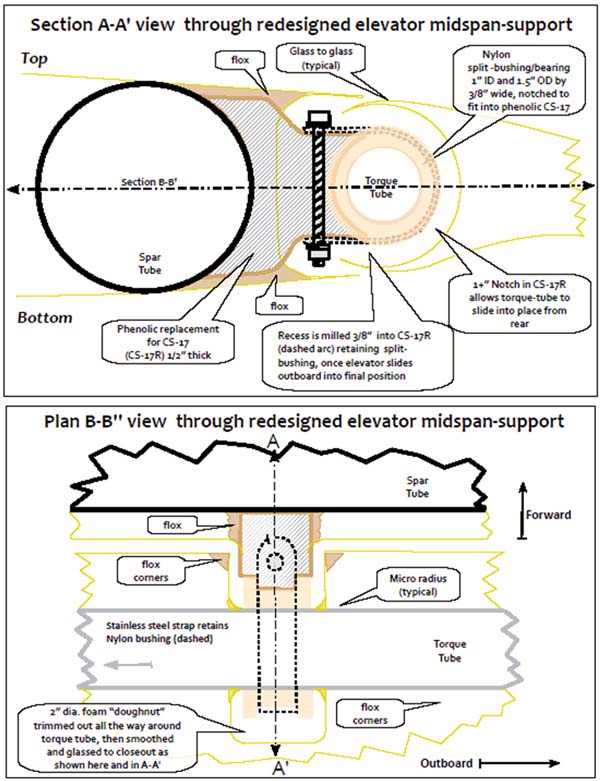
My design is the final of several interim versions. The various versions were modified as pros and cons were weighed along with the advice of various experienced Q builders and engineers. The format of this design is not unlike the elevator hinge pivots on the entire line of Waco biplanes. In the case of the Waco, the split bushing is made of phenolic and the retaining strap is a U-bolt that pulls the bushing against a retaining block and is bolted through and tightened against the back side of the elevator spar. This design has been flying for more than 70 years with little or no problem, so I feel like the design I am using is not that far from a proven approach.
The hinge, prior to installation, is shown in the two pictures below:
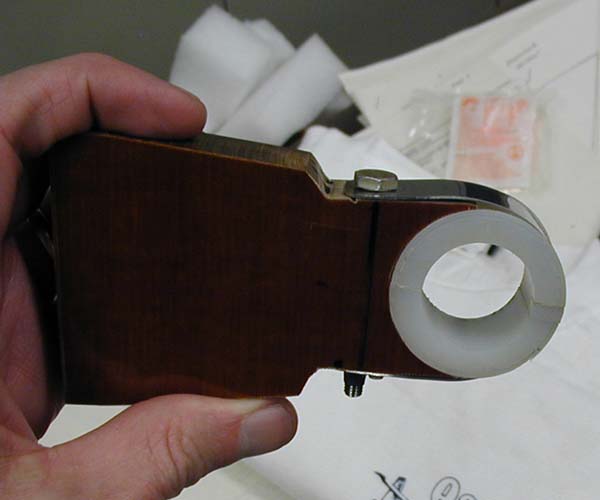
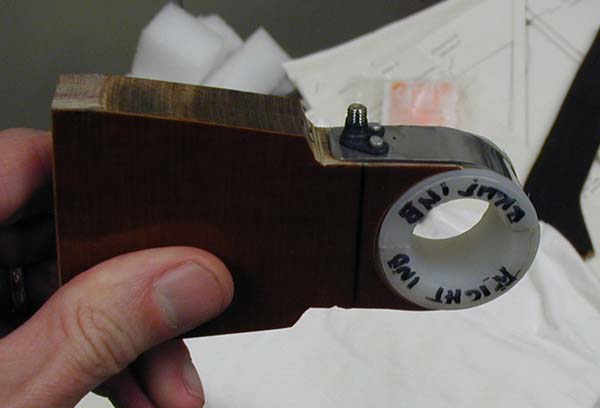
A nut plate is riveted to the stainless strap to capture the AN3 retaining bolt. This change was made to simplify installation. A nut is shown in the design schematic, but the nut plate proved more serviceable. The Phenolic block is ½” thick and was trimmed to match the curvature of the carbon fiber LS-1 spar prior to installation. The trimmed phenolic CS-17 was fit though the elevator slot core and floxed in place on the spar, then this was glassed to the slot core for security. In addition, the half of the nylon split bushing that fits into CS-17 was screwed into CS-17 to hold it fixed and simplify installation. See below.
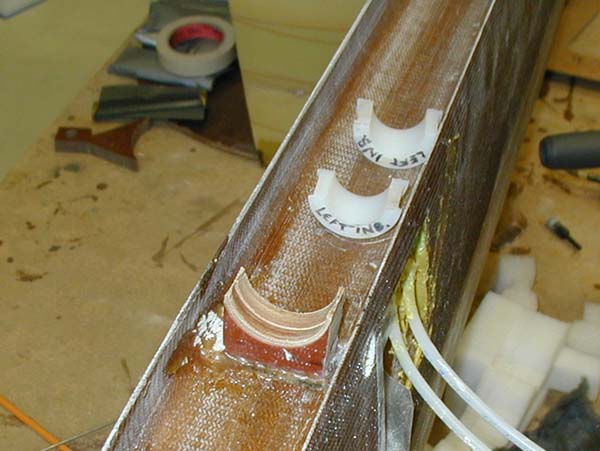
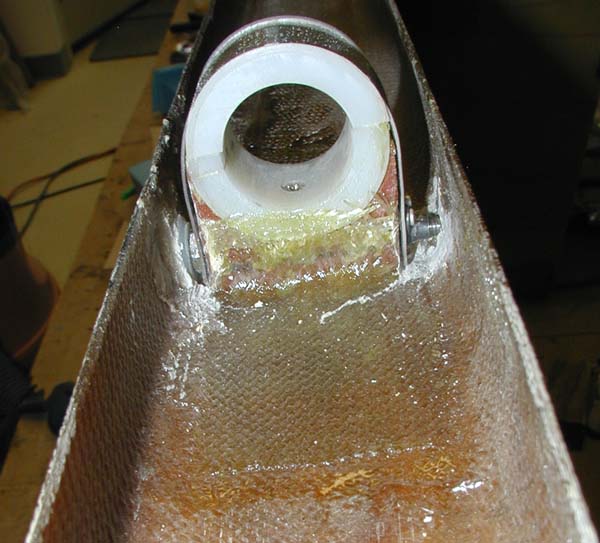
A hole was drilled in the bottom of the slot core to allow access to the AN3 retaining through-bolt. The bolt is installed from the bottom of the wing while the strap is held in place using a screw driver pushing on the nut plate. The photo below shows the hinge being test-assembled without the elevator in place by installing the through-bolt with a socket driver.
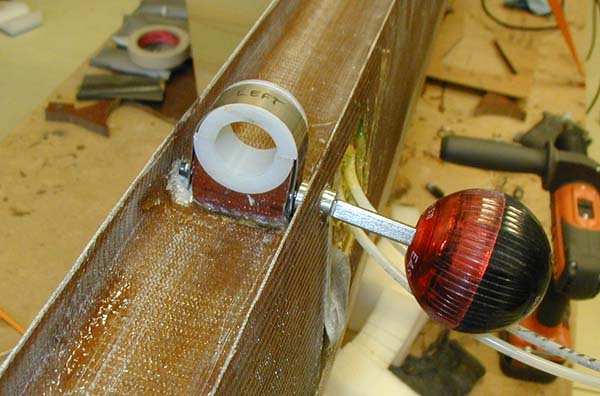
The nyloflow tubes you see are for the pitot AOA system which is now installed.
The elevator torque tube and is exposed by cutting away the glass and foam around the tube where the hinge attaches. A 3/32” wall aluminum tube with the same OD as the ID of the torque tube was turned on a lathe and cut to 4” length to use as a stiffener (photo below). This stiffener was slid inside the torque tube and cherry riveted in place to give additional strength to the exposed torque tube area.
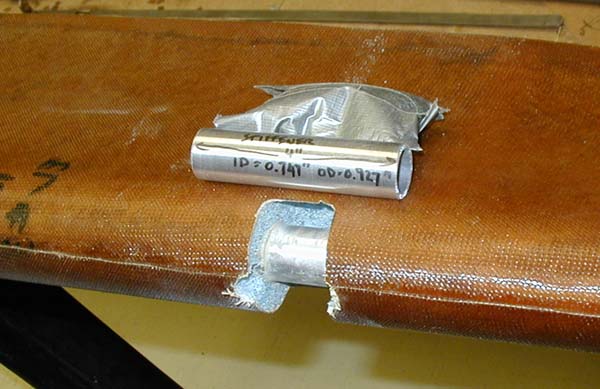
The cherry rivets and the carved out area in the elevator can be seen more clearly in the following photo. The blue foam area will be closed out with flox and one ply of glass prior to final assembly. The area between the two pop rivets is where the nylon bushing rests. The enlarged opening to the left is required to allow inboard travel for the removal of the elevator from the outboard hinge pin once the stainless strap has been loosened.
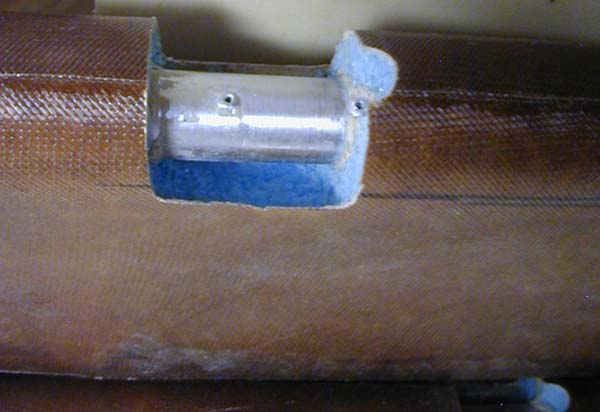
The following photo shows the elevator with the redesigned hinge installed.
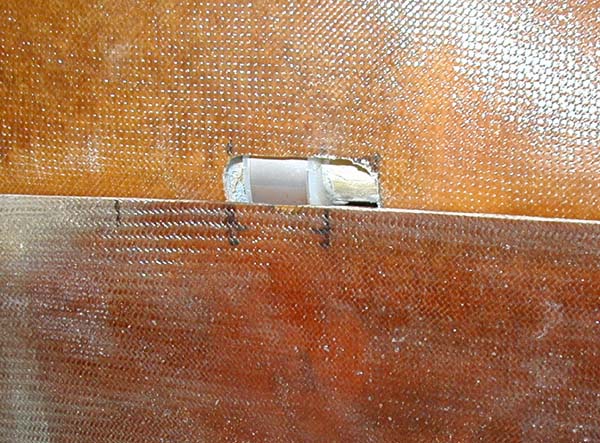
The exposed gap on the elevator will be covered by a small aluminum access plate retained by screws.
The access to the bolt leaves a hole in the bottom of the slot core. This is not a large problem, but may cause drag or unwanted airflow from the bottom side of the wing through the elevator slot. In addition, since the retaining bolt is installed from below, if it should become loose, it could potentially drop out. To solve both of these problems (seal the hole, and provide a safety for the bolt), a threaded nylon rod was trimmed and floxed into the hole after coating the threads with mold release. A little trimming and a slot cut into the rod results in a threaded plug that snugs up against the head of the AN3 through-bolt.
This plug can be checked as a pre-flight inspection point to verify security. See photos below.
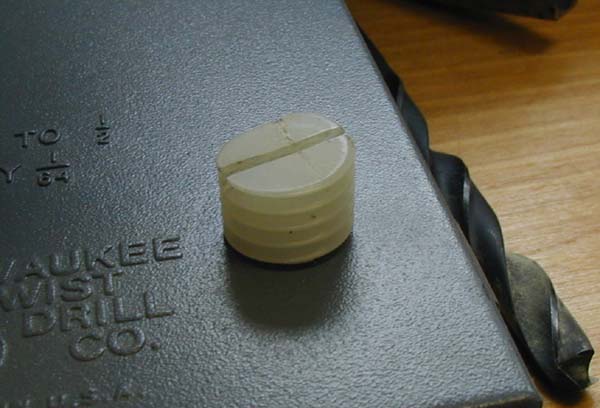
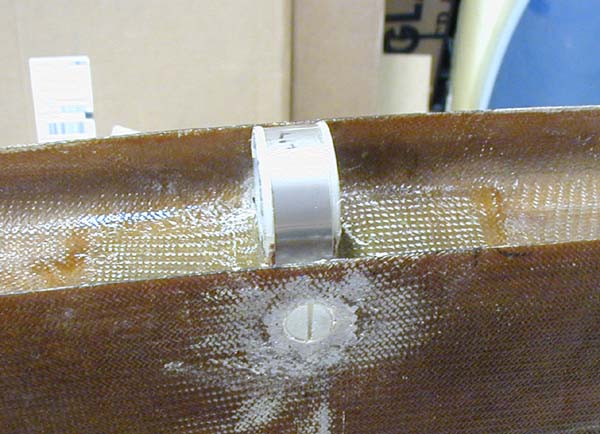
Summary:
The redesigned midspan hinge allows easy elevator installation, is very low friction. Holds large side and rear loads securely, and will lead to less corrosion and fatigue than the original QAC design. I look forward to reporting the performance of this mod in flight tests, just as soon as I can get there.
Cheers,
Jay Scheevel
Tri-Q, still building
Jay,
This is an innovative solution to the mid-span issue. I look forward seeing how it works for you.
I do not remember the details, but we did have an in-flight failure of the mid-span elevator a few years ago [See accident report below], with dire consequences. The NTSB determined that the builder had removed more of the torque tube than the plans called for and that tube had failed.
Other builders: This is a radical departure from the plans and while it may seem like a good idea, and maybe it is, it is UNPROVEN. So, IMHO this does not mean that you should install it yourself, but that you should see how it works out for Jay, wait for his feedback, then proceed cautiously from that point. (This sage advice from someone who tends to jump in blindly).
Please keep us informed.
Sam Hoskins
To learn more about the accident caused by the mid-span elevator pivot failure, please do a search for “Tom Curry” here on the website. This should return the following results:
http://www.quickheads.com/q-talk-124-post-accident-update.html
http://www.quickheads.com/q-talk-125-odds-and-ends.html
I linked to the accident reports (with pictures) from the bottom of each of those articles so that they are easier to locate. Those links also appear here for your convenience.
Tom_Curry--Branson_MO_factual_report.pdf
Tom_Curry--Branson_MO_materials_factual.pdf
Builders, it should also be noted that many Q's have flown thousands of hours with the mid span elevator pivot built “per plans,” So again, please seriously consider the consequences of any departure from the plans.
Be safe guys.
Dan Yager
QBA Editor
www.quickheads.com



